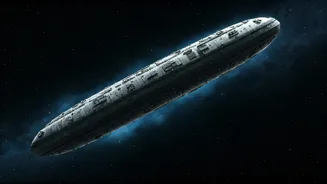Unveiling Interstellar Mystery
The universe, a realm of infinite possibilities, constantly presents us with enigmas. One such riddle, the interstellar object designated 3I/ATLAS, has
sparked intense curiosity and debate. The object, a visitor from another star system, initially triggered wild speculation, including the sensational idea of it being an alien mothership. The scientific community, however, often prefers to ground its explorations in empirical data and rigorous analysis. Consequently, a new theory has emerged, providing an alternative interpretation of 3I/ATLAS's nature, aiming to move away from speculative claims by grounding itself in known physics and astronomy.
Challenging Alien Theories
The initial speculation around 3I/ATLAS was fueled by its unusual trajectory and unexpected behavior. This, combined with the inherent human fascination with extraterrestrial life, led some to suggest it was a vessel or instrument related to an advanced alien civilization. Such theories, while captivating, required extensive evidence to support them. The new theory posits that 3I/ATLAS's observed characteristics can be explained by natural phenomena, thereby providing a less fantastical, yet equally compelling, understanding. This shift emphasizes the importance of scientific rigor and skepticism in the face of extraordinary claims, requiring compelling evidence before fully accepting the claims.
Alternative Origins Explored
The new theory regarding 3I/ATLAS focuses on natural formation processes, proposing that it could be a remnant of planet formation from another star system. This perspective suggests the object is composed of materials that are commonly found in space. This stands in stark contrast to the idea of artificial construction and alien technology. The alternative origin also brings into question 3I/ATLAS's characteristics. It proposes these unusual attributes may be the result of its journey through interstellar space, encountering cosmic radiation or being subjected to other forces, as opposed to deliberate design.
Deciphering Composition And Behavior
Understanding the composition of 3I/ATLAS is crucial to testing the new theory. Scientists are using various methods to analyze its spectral data, which is the light it emits or reflects. These analyses will reveal the materials that make up the object. This information is then compared with the known compositions of cosmic objects, like comets and asteroids. The behavior of 3I/ATLAS, including its speed and trajectory, is also under scrutiny. This data is analyzed and can be simulated using computer models to study the interactions with space environments. These studies help reveal the object's origin and provide important insights into the environments it encounters.
Future Research Directions
The study of 3I/ATLAS is an ongoing effort. Future research will depend on enhancing the current data. Improved telescopes and more advanced analytical techniques will permit scientists to observe 3I/ATLAS in even greater detail. This will allow for more refined data analysis. Additional missions to explore interstellar objects may be planned. Such exploration will provide in situ data about the composition of these objects. These new observations, coupled with theoretical models and computational simulations, will hopefully lead to a clearer picture of 3I/ATLAS and its nature. This will hopefully help resolve many mysteries about its interstellar journey and its origins.

